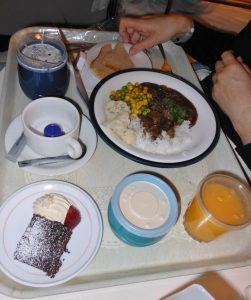5.7 Conversions
[latexpage]
Ounces to Milliliters
When caring for patients, nurses often need to convert between ounces and milliliters. Although these equivalencies are typically memorized, let’s start with a simple problem of converting ounces to milliliters to demonstrate the technique of dimensional analysis.
Practice Problem #1: Ounces to Milliliters
A patient drank an 8 ounce can of juice. The nurse must document the intake in milliliters. How many milliliters of juice did the patient drink?
Here is an example of how to solve this conversion problem using dimensional analysis.
1. Identify the unit being solved for as the goal. In this example, we want to convert the patient’s oral intake from ounces to milliliters, so we are solving for milliliters (mL):
\[mL~=~?\]
2. Set up the numerator in the first fraction to match the desired unit to be solved. In this case, we want to know how many milliliters should be documented, so mL is placed in the numerator. To complete the fraction, we add information already known. In this example, we know that 30 mL is equivalent to 1 ounce, so 30 mL is added to the numerator and 1 ounce is added to the denominator:
\[
mL~=~\frac{30~mL}{1~ounce}
\]
3. Add the second fraction to the equation. When using dimensional analysis, fractions are set up so the same units are diagonal from eachother so they cancel each other out, leaving the desired unit. For this problem, the second fraction is set up to include ounces in the numerator so that it will cancel out ounces in the denominator of the first fraction. “8” is then added to the numerator because we know from the problem that the patient consumed 8 ounces. “1” is then added to the denominator because the purpose of the second fraction is to cancel out units:
\[
ml~=~\frac{30~mL}{1~ounce}~x~\frac{8~ounces}{1}
\]
4. Cancel out similar units that are diagonal to each other. After canceling out ounces, we are left with our desired units of mL:
\[mL~=~\frac{30~mL}{1~\cancel{ounce}}~x~\frac{8~\cancel{ounces}}{1}\]
5. Multiply across the numerators and then multiply across the denominators:
\[mL~=~\frac{30~mL}{1~\cancel{ounce}}~x~\frac{8~\cancel{ounces}}{1}~=~\frac{30~mL~x~8}{1~x~1~=~1}~=~{240~mL}
\]
6. Divide the numerator by the denominator to get the final answer with the desired goal unit:
\[\frac{240~mL}{1}~=~{240~mL}
\]
Practice Problem #2: Ounces to Milliliters
In a similar manner, dimensional analysis can be used to calculate a patient’s total liquid intake on their meal tray. See Figure 5.6[1] for an example of a patient’s meal tray in a hospital setting.

Sample scenario: Your patient consumed 8 ounces of coffee, 4 ounces of orange juice, and 4 ounces of milk. How many milliliters of intake will you document?
Calculate using dimensional analysis.
1. Add up the total intake in ounces: \[{8~+~4~+~4}~=~{16~ounces}\]
2. Start by identifying mL as the goal unit for which you are solving. In this case, we want to know the number of milliliters:
\[mL~=~?\]
3. Create the first fraction by matching milliliters in the numerator. Then, using known equivalency that 30 mL is equal to 1 ounce, place 30 in the numerator and 1 ounce in the denominator:
\[
mL~=~\frac{30~ml}{1~ounce}
\]
4. Create the second fraction to cross out units. You know you want to cross out ounces, so place ounces in the numerator. Then, add the known amount of ounces consumed, which was 16:
\[
mL~=~\frac{30~mL}{1~ounce}~x~\frac{16~ounces}{1}
\]
5. Multiply across the numerators and then the denominators. Divide the numerator by the denominator of 1 for the final answer in mL:
\[mL~=~\frac{30~mL}{1~\cancel{ounce}}~x~\frac{16~\cancel{ounces}}{1}~=~{30~x~16}~=~{480~mL}
\]
Video Review of Calculating Intake and Output[2]
Pounds to Kilograms
Converting pounds to kilograms is typically memorized as an equivalency, but let’s practice using the technique of dimensional analysis.
Sample problem: The patient entered their weight as 137 pounds on their intake form. Convert the patient’s weight to kilograms to document it in the electronic medical record. Round your answer to the nearest tenth. Calculate using dimensional analysis.
- Start by identifying kg as the goal unit for which you are solving. Then, set up the first fraction so that the numerator matches the goal unit of kg. For the denominator, add 2.2 lbs because the known equivalency is 1 kg is equivalent to 2.2 pounds. Set up the second fraction with pounds in the numerator so that pounds will cross out diagonally to eliminate this unit. Then, add the patient’s known weight (137 lb) in the numerator, with 1 in the denominator because the function of this fraction is to cross out units. Multiply across the numerators and then the denominators. Finally, divide the final fraction to solve the problem.
\[kg~=~\frac{1~kg}{2.2~\cancel{lb}}~x~\frac{137~\cancel{lb}}{1}~=~\frac{137~kg}{2.2~}}=~{62.2727~=~62.3~kg}
\]
Review modules 1.0 to 1.4 within SWTC’s Dimensional Analysis in Nursing page for more information about solving tablet problems:
- “Hospital Meal” by Michael Coghlin is licensed under CC BY-SA 2.0 ↵
- RegisteredNurseRN. (2018, February 26). Intake and output nursing calculation practice problems NCLEX review (CNA, LPN, RN) I and O [Video]. YouTube. All rights reserved. Video used with permission. https://youtu.be/a6ovyZIs9tg ↵

